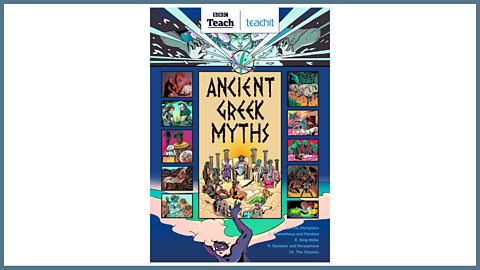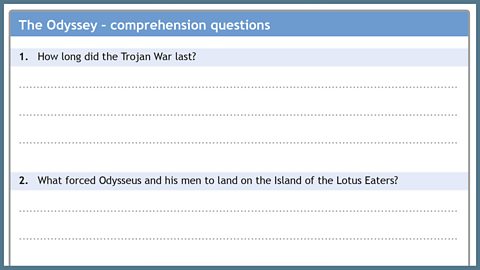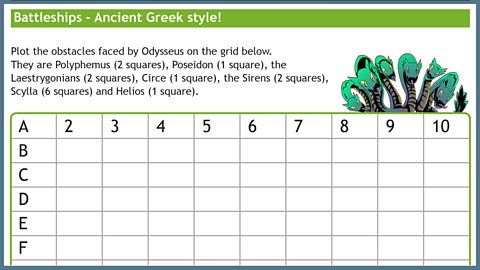After the Trojan War ends Odysseus sails for home - but his eventful journey is going to take 10 years.
The video
10: The Odyssey
The Trojan wars had ended. Odysseus, Greek hero and the King of Ithaca, was desperate to return home to his wife, Penelope, and their son Telemachus, who he had not seen for ten long years.
Odysseus and his fleet of ships set sail. The journey did not quite go to plan.
First off, huge storms forced them to land on the Island of the Lotus Eaters.
Odysseusâ men ate delicious fruit from the lotus trees that made them all forget about home, and lounge around in a daze. Odysseus forced them back on to the ships and they set sail again.
Next, running out of food and water they landed on what seemed like a nice quiet island and Odysseus took twelve men to explore. They found a cave, with cheese and meat. Jackpot! The men started to eat, but the owner of the cave, a giant one-eyed Cyclops called Polyphemus - whoâd have guessed that - returned with his herd of sheep.
The Cyclops gobbled down two menâŠthen trapped the others in the cave with a massive boulder.
Odysseus needed an escape plan.
The next day, the Cyclops gobbled down two more of Odysseusâ men.
Odysseus offered the Cyclops some delicious wine he had carried from the ship. The Cyclops drank it in one gulpâŠthen collapsed to the floor, asleep. It was very, very strong wine.
Odysseus and his men charged at the sleeping giant, jabbing a long spiky stick into his eye, blinding him.
Odysseus and his men attached themselves to the bellies of Polyphemusâ sheep and when the Cyclops let his herd out the next morning, the men escaped back to their ships and set sail once again.
Unfortunately for Odysseus, Polyphemus was actually the son of Poseidon, God of the sea. When Poseidon found out what had happened, he vowed to prevent Odysseus from getting home to Ithaca for another ten years.
Big trouble lay ahead. Their next hiccup was resting for the night near an island populated by man-eating giants called the Laestrygonians. They pelted Odysseusâ fleet with rocks, sinking eleven of the twelve ships. So now it was just Odysseus and the crew of his own ship. They sailed on and reached the island of Aeaea where the powerful witch Circe lived.
She put on a huge feast for them, but had drugged the food, so that half of the crew were turned into pigs. Odysseus had been warned what Circe might do and ate some special herbs that stopped her magic.
Next, they sailed past the Sirens who sang a song so beautiful it forced men to steer their boats toward them, only to be shipwrecked on the rocks. Circe had warned Odysseus about the Sirens and their song, so his crew put beeswax in their ears to avoid hearing it. But Odysseus, for some reason, wanted to hear it, and ordered his men to strap him to the mast of the ship so he wouldnât steer it onto the rocks.
Then came the violent whirlpool - Charybdis. They made it through.
Only for some of the remaining crew to be munched on by the six-headed monster, Scylla, who was waiting round the corner. Bad luck!
A pretty hectic trip so far!
Odysseus then landed the ship on the island of Thrinacia where the hungry crew found a herd of cattle and slaughtered them for food. Oh dear! The cattle belonged to Helios - God of the sun. Oops!
The gods punished Odysseus again by sending a storm that shipwrecked his last boat and drowned all his remaining crew.
After ten long years fighting at Troy, and another ten years of extraordinary adventures, Odysseus finally made it home to Ithaca, disguised as a beggarâŠonly to find that his wife and son had been fighting off other men who wanted to take his throne.
But Odysseus wasnât a man to mess with. He threw off his disguise and killed all the competition.
Happy endingâŠfor Odysseus and Penelope at least.

The Odyssey
Please note that the animation includes depictions of violence from Greek mythology. We advise watching before sharing with your class.
Synopsis
Odysseus, King of Ithaca, sails for home with his men at the end of the Trojan War. But they suffer misfortune after misfortune and encounter all sorts of obstacles along the way.
They put ashore at the Island of the Lotus Eaters, where the crew are overcome with sleep and Odysseus must rescue them; they are trapped in a cave by the Cyclops, Polyphemus; they must deal with the witch, Circe, who turns the crew into pigs; they must sail past the Sirens, whose song causes ships to be wrecked upon the rocks; they must negotiate the twin terrors of the whirlpool, Charybdis, and the sea monster, Scylla; they must escape from the Laestrygonians, who destroy all but one of Odysseus' ships.
When Odysseus finally makes it home to Ithaca he finds that his wife, Penelope, is resisting the approaches of several suitors.

Teacher Notes
Taken from the complete Teacher Notes. See Resources.
Before watching the video
Look at a map of Greece and the surrounding islands and sea. Explain that pupils will learn about a famous journey from Troy (believed to have been on the north west coast of Turkey) to Ithaca, a Greek Island. Ask children to locate both on a map and to consider the route Odysseus may have taken.
After watching the video
- And then what? Poor Odysseus and his men have to overcome many obstacles and face many dangers on their journey home from Troy. Ask pupils to complete Odysseusâ journey log - which has got into a mess in all the mayhem! - and then to cut and stick the events into chronological order. A template is provided.
- Battleships. On the grid provided, children plot each of the seven obstacles in the story (Polyphemus, Poseidon, the Laestrogonians, Circe, The Sirens, Scylla, Helios). They then pair up for a game of Ancient Greek battleships, where they choose coordinates at which to fire thunderbolts to destroy their opponentâs obstacles.
- Escape plan! Children must imagine they are Odysseus who is charged with advising other travellers of the dangers of the journey. They must choose one of the threats in the story and write a set of instructions to help travellers escape the danger. They could use Odysseusâ own escape methods or devise one of their own.
- Travel brochure. Children choose an island from the story and create a travel brochure or poster for it. How will they âsellâ the island when they must reference the danger that lurks there?
- And now for the news. Children work in groups of three to produce a news item about Odysseusâ adventure. One plays the news anchor, one plays the interviewer and one plays Odysseus. Groups should use the planning template to make notes on their different parts, making sure Odysseus is ready with his answers. If possible, children could use iPads to record their news items to share with the class. If no iPads are available, they can broadcast live!

Resources - Teacher Notes from Teachit
Comprehensive Teacher Notes covering episodes 6 to 10, including worksheets and activities.

Click to display the worksheet full-size or print it (taken from the Teacher Notes).

Click to display the worksheet full-size or print it (taken from the Teacher Notes).

The Teacher Notes for this series have been prepared in partnership with .

Other resources
±«Óătv Teach: Tales from Ancient Greece - audio versions of more popular Ancient Greek myths
